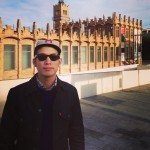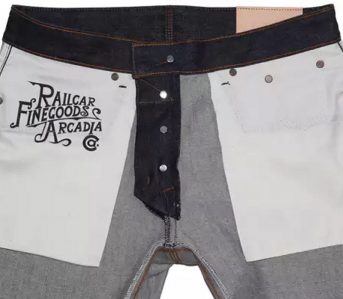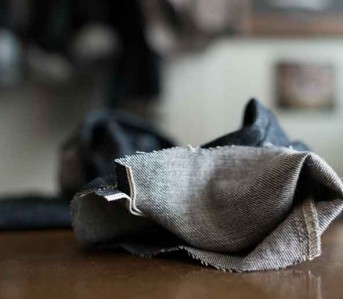
“Have you heard of this guy who makes jeans in his apartment in Oakland?”
This was 3 years ago and the first time I heard about Roy Slaper. At the time, he had just begun to gain some attention on forums like Superfuture and was generating some heated debates on what he was doing, and whether or not he’d really be a name that would matter in the future.
Since coming onto the scene with his first run of jeans, he’s continuously grown his reputation as an expert jeans maker. He has an unwavering focus on creating incredibly detailed and unique products made from some of the best fabrics and materials available.
For most of us, he seemed to come out of nowhere with a certain attention to detail and from a different perspective. Sure enough, he established him quickly within the denim world, albeit for Roy, it was anything but a quick and easy journey.

Methodically laid out machines
Roy Slaper
When you first meet Roy, you’re likely to make two observations: first, he’s rather tall; and second, he loves to talk and share stories. He has a specific tone and way of speaking where there is an intention and purpose behind every word. In his Oakland, CA workshop, it’s easy to see that same intention reflected in the entire space.
Everything in the workshop serves a purpose. The black sewing machines with gold lettering are lined up in a row to facilitate his workflow, with each of the machines specifically tuned and modified to perform a task. There is a certain uniformity and order in the controlled chaos of the workshop.
Throughout the space, you can see the leftover scraps of fabric and leather, patterns from his previous projects, and ideas for projects that haven’t come to fruition yet. It’s in this workshop that he spends his time experimenting with techniques, fabrics, and modifications to his machines so they’ll do exactly what he needs.
Taking a look at everything he has in the space, it’s hard to imagine him doing work anywhere else even though he didn’t always have the workshop.

The Story of Roy
In the beginning, it all started with him wanting to make a pair of jeans for himself in his apartment. He’d work his day job as a metalworker, then go straight home to sew. As he learned more, he began needing more machines and, being a skilled metal worker, he kept coming up with ways he could modify the machines to perform exactly the way he needed it to.
Jean making quickly turned into an obsession. He even replaced the furniture in his tiny studio apartment with over a dozen machines. When people would come by to pick up the furniture and ask why he was getting rid of it, he says their reactions were equivalent to the reaction you’d get if your apartment was overrun by cats and you tell people you need more room for more cats.
The only piece of “furniture” he kept in the apartment was a foam mat that he’d cut to fit in his closet and use as a bed. As ridiculous as it sounds, for Roy, this was just what he had to do. He couldn’t stop making jeans and learning. Ultimately, he gave into the idea of moving to a workshop after realizing he was creating a huge amount of noise for his neighbors in his old apartment building.
Sitting over burritos at one of the machine tables, we talked for hours and jumped from topic to topic. What struck me the most during our conversation was how meticulous and patient he is with everything. He very much subscribes to the ideal that in order for something to be great, it has to be given time, work, and patience.
As he explains the different experiences he’s had with building up Roy, the common theme is that he never rushed through any part of the learning process. By truly building his understanding of how machines, fabrics, techniques, and skill work together, he has never rushed a release without first being confident that the product is what he set out to make.
Even the fabrics he uses, which have been custom made for him mostly by Cone Mills, have gone through a significant amount of testing, sampling, and thought before being chosen for a specific project.
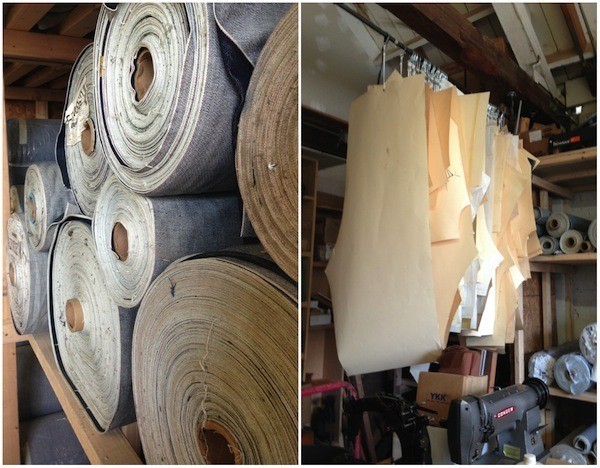
Cone Mills
As for why he uses Cone Mills, he’s heard the comparisons of their denim vs Japanese denim and he passionately defends Cone Mills against the reputation that it is second rate to Japanese mills. With each roll of fabric, he describes every characteristic of how each are made and dyed.
While Cone Mills typically does not produce fabrics that quickly show intense fading or have super slubby characteristics, they focus more on understated characteristics. That includes, but isn’t limited to, dyeing techniques, construction of fabrics and yarn, and achieving a more uniform appearance that develops character over time.
In a way, Cone Mills fabric is a lot like the products he makes: understated and never flashy, but when you look closely, they are well constructed and full of details that are uncommon in jeans across any price point.
He mentions that when he hears about new denim brands appearing everyday and how some are utilizing avenues like Kickstarter to fast-track their way from a producing a handful of samples to fulfilling thousands of orders. He wonders how this rapid trend of denim brands flooding the market with product will negatively impact people’s attitude towards selvedge denim.
Talking about what is happening today with denim and about the future gets him contemplating a lot about his own operation and what is going to happen in the future.

The Process
The way he’s set up right now is that he’s making 150+ pieces from start to finish for each run and is working at full capacity. There aren’t any more hours in the day for him to make more. When I ask him about whether he’s considered adding people to Roy to help him, he replies that he goes back and forth on whether or not he wants to expand the operation.
Adding more people would be beneficial to ease his impossibly busy schedule and allow him to offer more products. However, he hesitates due to the many logistical, operational, and financial hurdles. As we talk more though, I realize that aside from the logistical and financial hurdles he’d have to overcome, the hesitation really lies in that in its current form. Roy, the brand, is an embodiment of Roy Slaper the person and all the things he pays attention to and finds important in a pieces of clothing. Adding people to the operation would have many benefits, but also have the potential to drastically change the brand, how people perceive the brand, and even how Roy himself goes about creating clothes.
Although he won’t say it himself, it also seems that it’d be difficult to find someone who has the same eye and skill as he does and would be able to work at the same level as him.
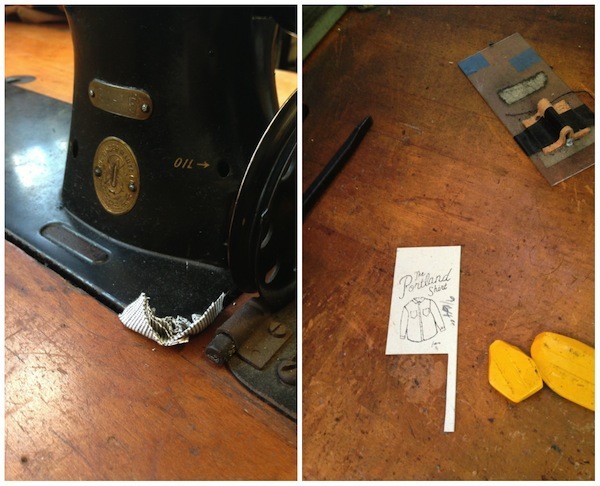
The Future
As for what’s coming up with Roy in the immediate future, he has a few ideas for the next release and the most probable release is quite special. It brings back some ideas that he utilized in a limited run of jeans he made for a Superfuture and Cone Mills contest.
The details are limited right now given that he is still making several final decisions before going into production mode, but it most likely will feature an improved cinch back design in a more modern cut. The aesthetics of the jean will differ from the previous runs he’s released and shows the growth and knowledge he’s gained over the years.
Everything from the type of fabric and thread to each techniques used have been examined, adjusted, and changed to provide a jean that not only will look different, but also age in a particular way.

Towards the end of our conversation, he stops himself mid-sentence and suddenly says that instead of simply adding people to his operation, he’d like to one day take on apprentices who are willing to take the time to learn the different techniques he’s learned, developed, and mastered.
Ultimately, he makes jeans not because it’s a lucrative business but because he loves making jeans and sharing his stories and knowledge with people. Thus, for him, this would be the natural path for all the work he’s put into the craft.
This is all far in the future right now though; he has too many ideas and too much love for the whole process right now to realistically think about that. It’s full speed forward for him and I’m positive I’m not alone in waiting to see what he comes up with next.
